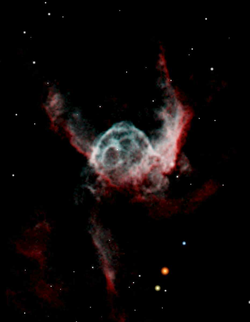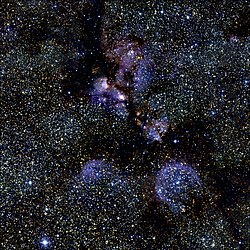Gumův katalog
Gumův katalog je astronomický katalog 84 emisních mlhovin na jižní obloze. Byl sestaven australským astronomem Colinem Stanleyem Gumem (1924-1960) na Mount Stromlo Observatory pomocí fotografií se širokým záběrem. Gum publikoval svá zjištění v roce 1955 v práci nazvané Studie jižních difuzních H-alfa mlhovin, ve které představil katalog 84 mlhovin nebo mlhovinových komplexů.[1] Podobné katalogy jsou například Sharplessův katalog a RCW katalog. Mnoho z Gumových objektů se vyskytuje i v těchto katalozích.
Podle Guma je pojmenována Gumova mlhovina, kterou objevil a zapsal do svého katalogu jako položku Gum 12, a jedná se o emisní mlhovinu, kterou lze nalézt v jižních souhvězdích Plachet a Lodní zádě.
Příklady
Příklady z Gumova katalogu (1955)
| Gum | Běžné jméno | Obrázek | Další jména a poznámky |
|---|---|---|---|
| Gum 4 | NGC 2359 |  | Thorova helma, Gum 4, Sh2 298, NGC 2359 |
| Gum 15 | RCW 32 |  | Gum 15, Region zrodu hvězd |
| Gum 16 | Zbytek supernovy v souhvězdí Plachet | (c) Harel Boren, CC BY-SA 4.0 | Gum 16, Vela Supernova Remnant |
| Gum 20 | RCW 36 |  | RCW 36 |
| Gum 29 | RCW 49 |  | Gum 29, RCW 49 |
| Gum 60 | NGC 6302 |  | Sh2 6, NGC 6302, Bug nebula PK 349+01 1, Motýlí mlhovina, RCW 124, Caldwell 69 |
| Gum 64 | NGC 6334 |  | ESO 392-EN 009, Sh2 8, RCW 127, Gum 64, NGC 6334 |
| Gum 66 | NGC 6357 |  | Sh2 11, NGC 6357, RCW 131, Gum 66, Mlhovina válka a mír |
| Gum 72 | Mlhovina Laguna |  | Sh2 25, RCW 146, Gum 72, Messier 8 |
| Gum 76 | Mlhovina Trifid |  | Sh2 30, M20, NGC 6514, RCW 147, Gum 76 |
| Gum 81 | Mlhovina Omega |  | Omega Nebula, M17, NGC 6618, Swan Nebula, Sh2 45, RCW 160, Gum 81 |
| Gum 83 | Orlí mlhovina |  | Sh2 49, Messier 16, NGC 6611, RCW 165, Gum 83 |
Reference
V tomto článku byl použit překlad textu z článku Gum catalog na anglické Wikipedii.
- ↑ GUM, Colin S. A Survey of Southern HII Regions. S. 155. Memoirs of the Royal Astronomical Society [online]. 1955 [cit. 2019-03-01]. Roč. 67, s. 155. Dostupné online. Bibcode 1955MmRAS..67..155G. (anglicky)
Externí odkazy
Média použitá na této stránce
Autor: ESO, Licence: CC BY 4.0
This image, based on data obtained with the Wide Field Imager (WFI) camera attached to the 2.2-m Max-Planck/ESO telescope through four different filters (B, V, R, and H-alpha), shows the amazing intricacies of the vast stellar nursery Gum 29. At its centre lies the cluster of young stars Westerlund 2. One object at the bottom of the cluster is in fact a system of two of most massive stars known to astronomers.
Autor: European Southern Observatory, Licence: CC BY 4.0
This richly detailed new view from the MPG/ESO 2.2-metre telescope at the La Silla Observatory in Chile shows the star formation region Gum 15. This little-known object is located in the constellation of Vela (The Sails), some 3000 light-years from Earth. The glowing cloud is a stunning example of an HII region. It also has a similarity to a more famous HII region, the Trifid Nebula (Messier 20).
Autor: ESO, Licence: CC BY 4.0
Three-colour composite mosaic image of the Eagle Nebula (Messier 16, or NGC 6611), based on images obtained with the Wide-Field Imager camera on the MPG/ESO 2.2-metre telescope at the La Silla Observatory. At the centre, the so-called “Pillars of Creation” can be seen. This wide-field image shows not only the central pillars, but also several others in the same star-forming region, as well as a huge number of stars in front of, in, or behind the Eagle Nebula. The cluster of bright stars to the upper right is NGC 6611, home to the massive and hot stars that illuminate the pillars. The “Spire” — another large pillar — is in the middle left of the image. This image is a composite of 3 filters in the visible range: B (blue), V (green) and R (red).
Blue: X-ray (Chandra); Green: 5.8 µm (Spitzer); Red 8.0 µm (Spitzer)
Autor: European Southern Observatory, Licence: CC BY 4.0
Three-colour composite image of the Omega Nebula (Messier 17, or NGC 6618), based on images obtained with the EMMI instrument on the ESO 3.58-metre New Technology Telescope at the La Silla Observatory. North is down and East is to the right in the image. It spans an angle equal to about one third the diameter of the Full Moon, corresponding to about 15 light-years at the distance of the Omega Nebula. The three filters used are B (blue), V ("visual", or green) and R (red).
NGC 2359
NGC 6302
NGC 6334 "Cat's Paw Nebula", Scorpius Constellation
(c) Harel Boren, CC BY-SA 4.0
Long exposure photograph of the Vela Supernova Remnant, taken from the Kalahari Desert in Namibia. This image shows the supernova remnant's northern section. The location of the Vela Pulsar, which is the origin of the supernova remnant, is approximately indicated by the annotation. North is to the left.
Total exposure time was 11:40 hours. Telescope was an Officina Stellare Riccardi-Honders Veloce RH 200 OTA, camera was an SBIG STL-11000M on an AP GTO1200 mount, guided with PHD.
Hvězdokupa NGC 6357 (Pismis 24) v jádru velké emisní mlhoviny NGC 6334 v souhvězdí Štíra Část mlhoviny je ionizována nejmladší těžkou hvězdou v Pismis 24 a vzniká tak velmi intenzivní ultafialové záření.












